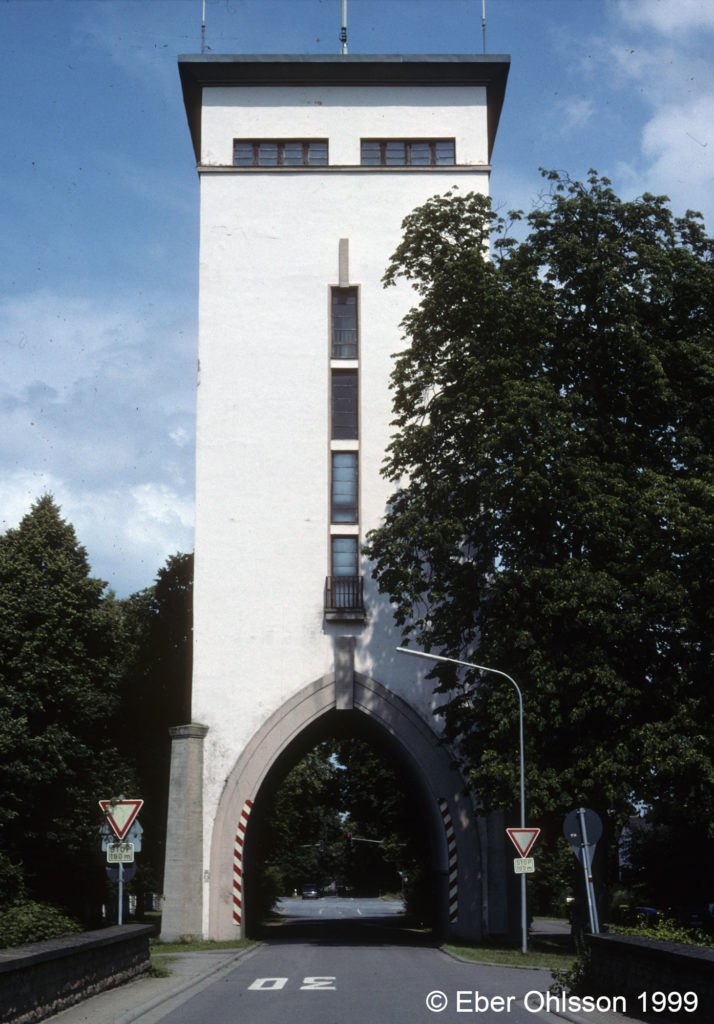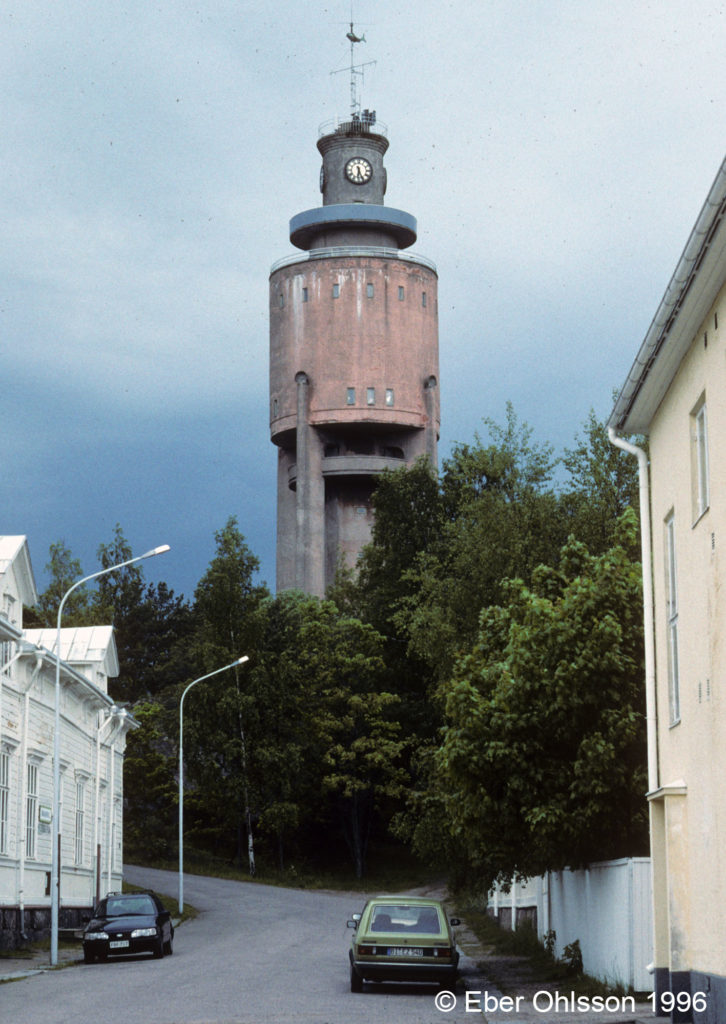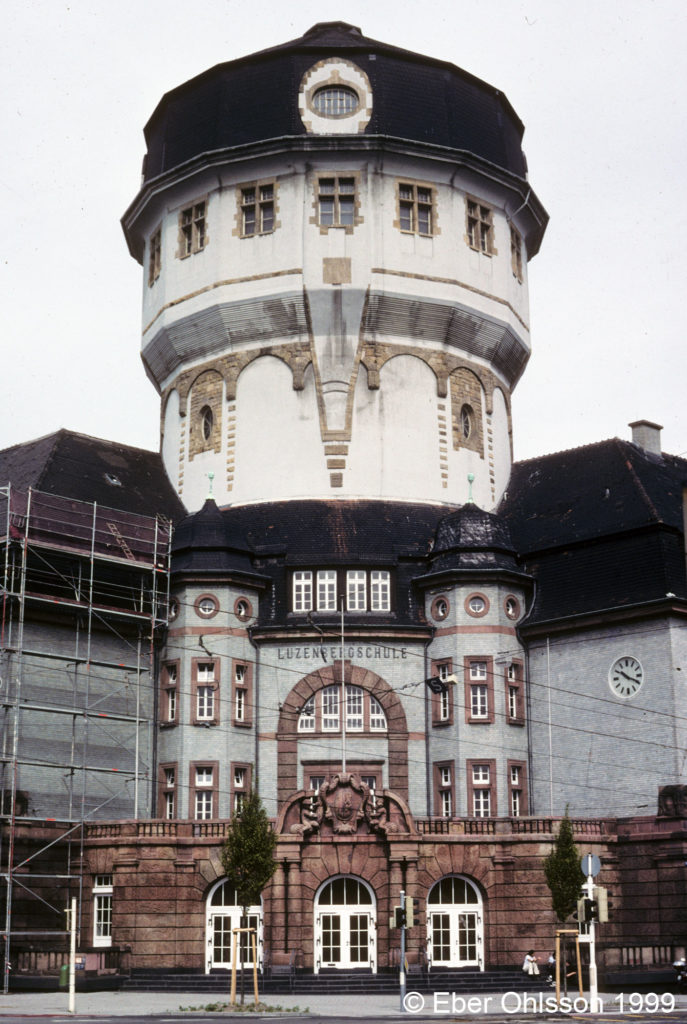Eber’s water towers 2000
The leading trade journal in Sweden, VA-tidskriften Cirkulation has since 1998 an article series under the heading Ebers vattentorn (Eber’s water towers), where Eber Ohlsson with text and photo presents interesting water towers in the world (except Scania and Sweden). Below is a free translation to English of these texts.
Eber’s water towers in Cirkulation 1/2000

The Swedish expression, that even is ambiguous (translated) “make a snip” has a comparing expression in English “make a good bargain”.
A free translation to English:
In the small Danish town Sakskøbing on Lolland was there built a 33 metres high water tower 1908. The reservoir volume was not overwhelming, only 60 m³. A common Danish water tower in other words. The only distinctive character was the vane in form of a sheep shears, an allusion on the town’s the coat of arms. The big change came when architect Fleming Skude draw a proposal to paint the tower.
The year 1982 was the face at the reservoir painted, with two windows on the tower as eyes and the roof as a naturally hat. The tower was out of operation 1985, but is today the town’s face against the world around and will be found on signs and brochures. “Saxine – the smiling water tower” was a face lifting and a real good bargain of the town.
Published 2000-02-16
Eber’s water towers in Cirkulation 2/2000

A free translation to English:
In Babenhausen, Germany has it been possible to drive cars under the water. Straight over the Bürgermeister Rühl-Straße [Mayer Rühl Street] in this town in southerly Hesse [Hessen] is a water tower standing since 1928 like a medieval town gate tower. The brick-built tower with a height of 31 metres and with a quadratic base of 10 metres is laid on four pillars of Hesse basalt and it’s been crowned by a copper roof.
The tower with a reservoir volume on 2 000 m³ had a cost at that time of 300 000 German Reichsmark. Constructer was the Mannheim firm Brand and the tower is considering as a typical work of this firm. With a width of 6 metres bridge the Gothic valve over the axle between the medieval city castle of Babenhausen and the hunting seat in Harreshausen.
The tower, that under the Second World War was doing duty as an archive to important documents of the town, is now out of operation and declared as a historic building.
Published 2000-03-22
Eber’s water towers in Cirkulation 3/2000

The name of bilingual town is in Finnish = Hanko and in Swedish = Hangö.
A free translation to English:
Grey and apparently gloomy water tower sits in state on the hill in Hanko/Hangö, the southernmost town in Finland. But the tower is coloured by the history. It was finished 1943 just while the war was raging, and replaced at that time a water tower in granite from 1910. The old tower had the Russian burst 1941, when they were forced to leave the leasehold zone Hanko/Hangö.
The new 48 metres high tower, with a reservoir standing on among other things four rectangular pillars, is designed by engineer Nikander and architect Bertel Liljeqvist. On the top of the of the pillars should originally mermaid decorations has been placed, but because of the expense sit in state there now shells, shaped by the sculptor Gunnar Finne.
Above the reservoir on 490 m³, is there a belvedere, from where you can see over the water of Hanko/Hangö. The first tower on this place was a fire tower in tree that stood there 1886-1910. All the three towers had one detail common, a clock in all the four cardinal points. In other words – they bear the impress of the times.
Published 2000-05-03
Eber’s water towers in Cirkulation 4/2000

The Swedish expression “Förvara och försvara” will translated to English be “Keep and defend”.
A free translation to English:
Keep and defend. It is words that can be used on the water tower in the Jutland town Fredericia. The town, that celebrates the 350th anniversary this year [2000], has one of the best preserved town-fortification in Scandinavia. On the top on one of the bastions, Prince George Bastion is a white water tower standing since 1909. It was moreover the same year that the Bastion Fredericia was discontinued.
The tower is 16 metres high and has on the top crenulations that allude to a medieval defence tower. It was entrepreneur Gudnitz from Copenhagen that for 24 500 Danish crowns built the water tower in reinforced concrete.
Above the reservoir on 440 m³ is there a belvedere that is open to the public under the summer season. From here is it a brilliant view over Danish waters, not least the Little Belt. The tower will defend its place.
Published 2000-06-07
Eber’s water towers in Cirkulation 5/2000

A free translation to English:
The earlier times water demanding railway traffic – steam locomotives, demand that this small mobile water reservoirs now and then was filled up with new water. For this purpose were there built stationary water reservoirs, often small standard water towers.
There are examples of more individual forms, as the water tower at Dortmund Südbahnhof [South Railway Station]. The German State railways built 1927 a 43 metre high water tower in reinforced concrete, which was designed by the architects H Lehman and M Venner.
Except two concrete cylinders, with a total reservoir volume on 800 m³ in the upper third part of the building was the tower even filled with office, room to accommodations and baths for the railway staff. The façade, there the floor is marked with horizontal plaster cornices, is oriented to the brick expressionist idiom of the “Amsterdam school”.
The reservoirs that was supplied from the common main supply, was in operation until the swan song of the steam epoch in the end of the 1950s. The water tower is now a historic building.
Published 2000-08-30
Eber’s water towers in Cirkulation 6/2000

A free translation to English:
A fastidious version of water tower is perhaps the first impression you get, when you see the water tower in the old hanseatic town Groningen in the north Netherlands. The tower that is standing in the yard in a central residential quarter represent a type of reservoir that is called a Barkhausen-reservoir after its originator, a professor in Hanover [Hannover].
The water tank has the form of a cylinder that downwards is transformed into a half sphere. The vertical struts are fastening in the transition between these geometrical forms. It is a simple type to manufacture and there are not either arising complicated powers of pressures.
The water tower in Groningen is built 1908 by A. Wilke & Co, Brunswick [Braunschweig] in Germany and is presumed to be designed by Carl Franke, Bremen. It is 45,3 metres high and was holding 1 000 m³ water, before it got out of operation about 20 years ago [2000].
Published 2000-10-04
Eber’s water towers in Cirkulation 7/2000

A free translation to English:
On a high river bank on the western bank of the river Tagus [Tejo], is there since 1979 standing a yellow water tower in concrete. The carrying part of the tower consist of three half cylinders, with the openings out. The half cylinders is transformed in the upper part into three closed cylinders, that together make up the reservoir on 1 000 m³. This water tower has the name in Portuguese Reservatório elevado do Rapouso.
The writer came once 1982 to the tower, and asked some questions about the water tower to the engineer that work with a pump installation in the basement. The engineer had no time to answer my questions, because he and his installation staff should go and have lunch, but if I was interested I could walk up in the tower.
That was done and up in the tower I got a marvellous view over the city that is on the other side of the river Tagus – Lisbon [Lisboa]. Nowadays is the water tower enclosed with a two metre high fence, and crested with barb wires.
Published 2000-11-08
Eber’s water towers in Cirkulation 8/2000

A free translation to English:
School examples of water towers are there in the Badische city Mannheim in Germany. In the district Luzenberg is the water tower and the school an integrated building complex. This quite not usual combination began 1907-08 when the water tower was built as a solitary.
Thereafter was under the year 1912-14 the school built, in main two wings up to the tower. The inner room decoration of the school was not unexpectedly based on the theme water. The water tower is 56 metres high, and had a reservoir on 2 000 m³ before it was out of order 1970.
Now has the tower been a very high circular “acoustic” junior common room with cafeteria to pupils of the school. Today’s modest tower roof is a new construction, as the bombing under the Second World War damage the old roof, a roof with steep raising, finished with a sphere.
In spite of the reduced height of the tower is the building a marked element in the general aspect of the town and has been the symbol of Luzenberg. Rightly has the Art Nouveau water tower been declared as a historic building.
Published 2000-12-13
